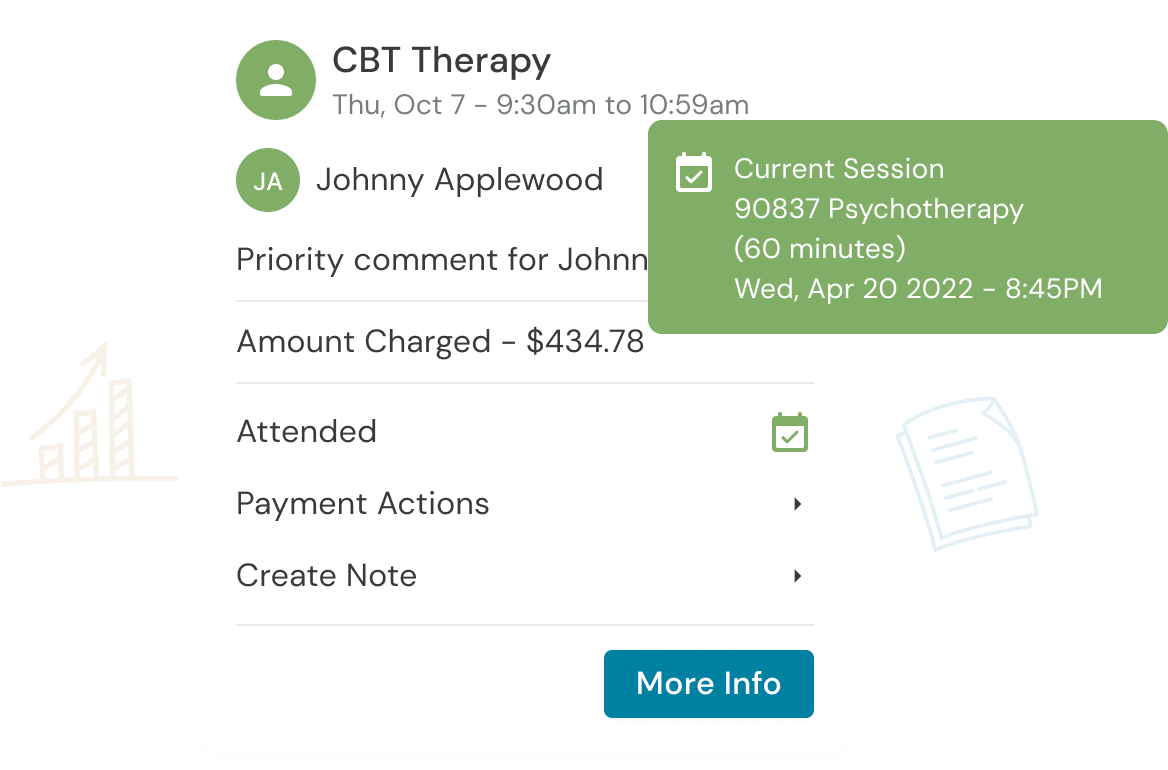Why Is Setting Therapy Rates So Hard (But So Important)?
Figuring out how much to charge as a therapist can bring up a lot of feelings. Self-doubt. Guilt. Maybe even a sense of imposter syndrome. If that’s you, you’re not alone — and it’s okay.
But here’s the thing: your fee isn’t just a number on an invoice. It’s the foundation of a sustainable practice, one that supports both your clients and your own well-being. It reflects your time, your expertise, and your ability to keep doing this work without burning out.
When you get clear on your value and what you actually need to run your business, setting rates becomes less about fear — and more about freedom.

How Do You Calculate What to Charge as a Therapist?
Know Your Numbers: Start with the Basics
Before you look at anyone else’s rates or browse a directory, take a hard look at your own financial needs.
Start by breaking things down into three categories:
- Living expenses: Your rent or mortgage, groceries, transportation, health insurance, savings — the essentials.
- Business costs: Think office rent (if you have one), practice management software like Owl Practice, liability insurance, CE credits, marketing, and supervision.
- Admin time: Billing, note-taking, client outreach, networking — anything that doesn’t bring in income but still eats up hours.
Then ask yourself: How many clients can I realistically see each week without sacrificing quality of care or burning out? Maybe it’s 15. Maybe it’s 25. Do the math. Multiply that by your number of working weeks per year. That’s your available billable time.
Once you have all of that, you can reverse engineer your minimum hourly rate — one that keeps your business afloat and you, the human behind it, thriving.
Therapist Rate Calculator
Use our Therapist Rate Calculator to help figure out at what rate you may want to charge for your sessions to meet your income goal.
What Do Other Therapists Charge? And Should You Care?
Understand the Market: Context Matters
After you’ve calculated your baseline, it’s time to look outward. Knowing what other therapists charge in your area helps you stay competitive — and informed.
Here’s where to start:
- Check therapy directories to see common therapy practice rates in your city or province.
- Consider your niche. If you specialize in something high-demand like trauma, couples therapy, or ADHD, you may be able to set a higher rate.
- Look at whether local clients typically use insurance or pay out of pocket.
But be careful. It’s easy to get swept up in comparison, especially early on. Just because someone with your credentials is charging $90 or $200 doesn’t mean that number is right for you.
Let your market research inform your rate — but let your own needs drive the decision.
How Does Psychology Impact Pricing for Therapists?
Reframe Your Mindset: Pricing Isn’t Personal
Here’s a tough truth: undercharging doesn’t serve anyone — not your clients, and definitely not you.
It’s easy to fall into the trap of thinking that lower fees equal more compassion. But the reality is, consistently charging below what you need can lead to resentment, exhaustion, and even a failing practice. That doesn’t help your clients — it hurts them.
Pricing is not a moral issue. It’s a business one.
When you charge a fee that reflects your value, it signals professionalism. It sets the tone for boundaries. It creates safety for both you and your clients.
And yes, you can still offer flexibility. Many successful therapists create room for sliding scale slots, but they do it with intention, not guilt. They decide how many reduced-fee spots they can sustainably offer, set clear policies, and revisit those decisions regularly.
What Mistakes Should New Therapists Avoid When Setting Rates?
Don’t Undervalue Yourself from the Start
When you’re new in private practice, it’s tempting to play it safe. Maybe you set your rate low to fill your caseload quickly. Maybe you base it on what your therapist friends charge.
But these early decisions can lock you into patterns that are tough to undo.
Here are a few common traps to avoid:
- Setting a low fee “just for now” without a plan to raise it.
- Copying other therapists’ rates without knowing their goals, costs, or client load.
- Forgetting to account for taxes, time off, and non-billable hours.
- Offering sliding scale to everyone because it feels hard to say no.
- Failing to build in space for future growth: both professionally and financially.
A solid guide to setting therapist practice rates includes more than just numbers. It includes a strategy for how those rates can evolve as your practice matures.
How Do You Talk to Clients About Your Rates?
Communicating Clearly (Without the Awkwardness)
Stating your rate out loud can feel more intimidating than actually picking one. That’s totally normal. But when you speak about your fees with clarity and calm, clients feel that confidence, and they respond to it. So practice saying your rate until it rolls off your tongue. Literally. Say it in the mirror. Role-play with a colleague.
Something simple and direct works best: “My fee is $150 per 50-minute session. I also offer a limited number of sliding scale spots.” No apologies. No hesitation. Just facts. Use value-based language when needed. Instead of framing therapy as a cost, talk about it as an investment in change, healing, or growth.
Make sure all of this is communicated upfront — ideally before your first session.
Can Your Therapy Rates Change Over Time?
Your First Rate Isn’t Your Forever Rate
Here’s a secret: most successful therapists raise their rates regularly, and you should too.
Over time, you’ll gain experience, expand your skills, and likely become more in demand. Your business costs may go up, your caseload may fill, or your personal needs might shift. Your rate should reflect all of that.
You don’t have to make a dramatic leap. Even small increases (with notice) make a big difference over time. Many therapists review their rates every year or so — sometimes more frequently if they reach capacity.
When raising your fees:
- Give your clients advance notice (typically 30–60 days).
- Offer options for those who may be impacted — like referrals or a phased increase.
- Stay clear, kind, and professional. Most clients will understand.
And remember: raising your rate isn’t greedy. It’s growth.
FAQs About Setting Therapy Rates
What’s a good starting rate for a new therapist?
That depends on where you’re practicing and your financial needs, but many early-career therapists start between $100–$150 per session. Make sure you run the numbers based on your business expenses and personal budget.
Should I offer sliding scale rates?
Yes — if you can do so sustainably. Set limits upfront and use a consistent process for determining who qualifies. Owl Practice helps you manage different rates smoothly within one system.
How often should I raise my rates?
Every 12–18 months is common, especially as you gain experience or become fully booked. Be transparent with clients and offer support as needed.
What if clients can’t afford my rate?
That’s okay. You’re not the right fit for everyone. Offer a sliding scale if you have space, or refer them to a trusted colleague or low-cost clinic.
How do I manage invoicing and payments?
Use a secure, all-in-one platform like Owl Practice. Owl Practice makes it easy to send invoices, accept payments, and track your earnings — without the spreadsheet stress.
Final Thoughts: Charge with Confidence, Grow with Intention
There’s no perfect formula for pricing your services. But there is a thoughtful, informed process — and it starts with believing your work matters.
When you anchor your rate in both your financial reality and your professional value, you’re building more than just a business. You’re building a practice that supports you just as much as it supports your clients.
You’re allowed to charge well. You’re allowed to grow. You’re allowed to change your mind as your practice evolves.
And you don’t have to do it alone. Owl Practice gives you the tools to manage your fees, customize billing options, and build the kind of private practice that lasts.

Start a Free Trial!
Reduce clinical administrative tasks and transform more lives with Owl Practice. Owl Practice provides all the tools you need to make your practice successful. Join the thousands of care professionals using Owl to run their practice every day.



